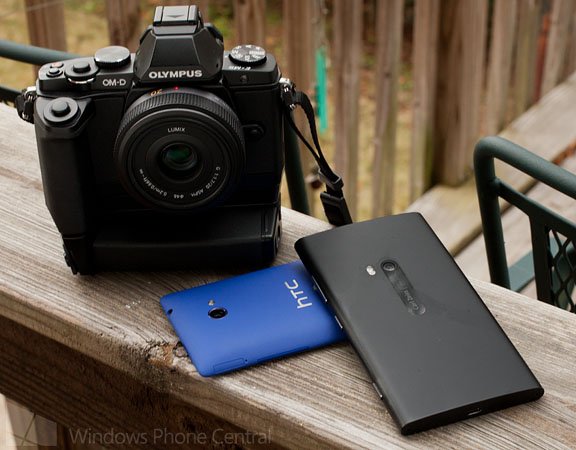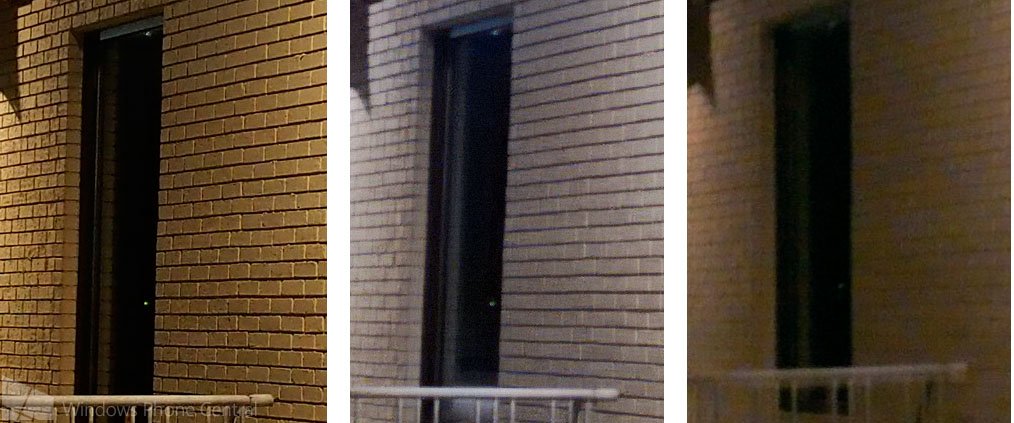How do flagship Windows Phone 8 cameras compare to a prosumer DSLR? We find out.

Windows Phone Camera Faceoff: HTC 8X, Nokia Lumia 920 and Olympus OM-D
The other day we shared a night photo comparison between the Nokia Lumia 920 Windows Phone and a Canon 1D-X DSLR. While the Canon 1D-X and Lumia 920 cameras are worlds apart, the Lumia 920 didn't do a bad job of capturing night photos. All of which made us wonder how the recent crop of Windows Phones would measure up against your run of the mill stand alone digital camera.
We recently took the HTC 8X, Nokia Lumia 920 and Olympus OM-D EM-5 camera out for a comparative test drive and the Windows Phone cameras didn't do to shabby of a job. The Olympus is a mirrorless camera that is similar is design to a "point and shoot" digital camera. It has a 4/3rds sensor shares the same 4:3 aspect ratio as the two Windows Phones and the camera has in-body stabilization which is loosely similar to the Lumia 920's.
While the Olympus OM-D isn't your typical run of the mill digital camera (closest we had) the settings were adjusted to come close to both the Lumia 920 and 8X. Basically we dialed back the Olympus to come close to the typical 8MP point and shoot style camera. Just for the record, here is the tell of the tape on the cameras used.
- Olympus OM-D EM-5: 16MP micro four thirds sensor fitted with a 14mm f2.5 lens (28mm equivalent). The Olympus has in-body stabilization (IBIS) that stabilizes the sensor on five axes (pitch, yaw, vertical, rolling, horizontal).
- HTC 8X: 8MP BSI 1/3" sensor with a 28mm f2.0 lens. The HTC does not have any stabilization methods.
- Nokia Lumia 920: 8.7MP BSI 1/3" sensor with a 26mm f2.0 lens. The Lumia 920 has optical stabilization (OIS) that stabilizes the entire camera housing. While we can't confirm, we suspect the stabilization covers two axises (pitch and yaw).
Test images were shot with the 8X and Lumia 920 set to default settings except for the aspect ratio which was set to 4:3 on both Windows Phones.
The Olympus was set to aperture priority (camera automatically determines the shutter speed) for f2.5 to match the aperture of the Lumia 920 and 8X as close as possible. ISO settings were set to automatic and the JPEG quality to medium on the Olympus to reduce the image resolution to just under 8MP.
All images have not been post processed beyond resizing them for publication. Each photo sample displays, from left to right, images captured by the Olympus OM-D, Lumia 920 and 8X. All photos were shot hand held. You can find the un-edited, full resolution images in this zip file (about 23MB).

Outdoor Photo Sample: Olympus OM-D, Lumia 920 and 8X
Get the Windows Central Newsletter
All the latest news, reviews, and guides for Windows and Xbox diehards.

Night Photo Sample: Olympus OM-D, Lumia 920 and 8X
The bottom line is that while we won't pretend that our Windows Phones can compete with stand alone digital cameras of the likes of the Canon 1D-X, Olympus OM-D EM-5 or any other prosumer level cameras. But for the most part, they can hold their own. You can see the advantage the larger sensor of the Olympus brings to the table in these extreme crops of the day and night samples.

Day Photo Sample Extreme Crop: Olympus OM-D, Lumia 920 and 8X

Night Photo Sample Extreme Crop: Olympus OM-D, Lumia 920 and 8X
I think the Olympus wins out with regards to sharpness and handles varying lighting situations better with regards to color balance. The Lumia 920 still has the better balance outdoors while the 8X does better with indoor lighting. The stabilization on the Olympus and Lumia 920 helps both cameras tackle night shots and the slower shutter speeds.

Indoor Photo Sample: Olympus OM-D, Lumia 920 and 8X

Outdoor Photo Sample: Olympus OM-D, Lumia 920 and 8X
As with the Canon 1D-X, the Olympus OM-D is a completely different camera from our Windows Phones. From the larger sensor, faster AF, interchangeable lenses, larger ISO range and basically more horsepower under these cameras are in a different category. While using the Olympus more or less like a point and shoot camera the two Windows Phones matched up nicely. But open up the Olympus and you begin to see the differences.
Still, the image quality coming from either the 8X and Lumia 920 is respectable in its own right. Consider it this way, Windows Phone cameras have advanced through the years from being a novelty feature to quality photographic tools. There is room for improvement (better white balance handling, boost in sharpness, etc.) and our Windows Phone cameras do have some limitations. Still these camera are evolving into nice general purpose devices for everyday snap shots, landscapes, and people pictures. If you're planning on more challenging subjects (e.g. sports, wildlife, anything that needs a flash, etc.) then you'll need to look to a DSLR or similar where faster auto focus, higher frames per second (burst rate) and better lens selection gives these cameras a significant edge.
Hopefully future generations of cameras will have faster auto focus systems, mechanical shutters, and more controls from the settings. We're not sure if such advancements will level the playing field but they sure would make things interesting.
George is the Reviews Editor at Windows Central, concentrating on Windows 10 PC and Mobile apps. He's been a supporter of the platform since the days of Windows CE and uses his current Windows 10 Mobile phone daily to keep up with life and enjoy a game during down time.

